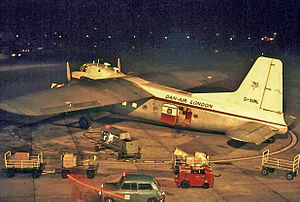Bristol Freighter
| Type 170 Freighter / Wayfarer | |
|---|---|
 |
|
| Bristol Freighter 31 of Dan-Air operating a cargo service at Manchester Airport in 1964. | |
| Role | Cargo aircraft |
| Manufacturer | Bristol Aeroplane Company |
| First flight | 2 December 1945 |
| Introduction | 1946 |
| Status | Retired |
| Primary user | Silver City Airways |
| Produced | 1945 - 1958 |
| Number built | 214 |
| Variants | Bristol Superfreighter |
The Bristol Type 170 Freighter was a British twin-engine aircraft designed and built by the Bristol Aeroplane Company as both a freighter and airliner. Its best known use was as an air ferry to carry cars and their passengers over relatively short distances. A passenger-only version was known as the Wayfarer.
The Bristol Type 170 was designed as a stop-gap project to provide work for the Bristol company while the Bristol Brabazon was under development. Subsequently, the Air Ministry expressed interest in the project, believing that it would provide a rugged transport aircraft capable of using unimproved airstrips, and two prototypes were ordered on the condition that the design was modified so that the aircraft could carry a British Army 3-ton truck, and Air Ministry specification 22/44 (later revised as C.9/45) was drawn up around the design.
The proposal was for an all-metal, twin-engine high-wing monoplane based on the pre-war Bristol Bombay, having wings of the same section and taper but with a swept leading edge and straight trailing edge with two spars in place of the seven used in the Bombay. The square-section fuselage was clear of internal obstructions; in the original design this was to be loaded via a trapdoor in the nose, but the Air Ministry requirements necessitated a change to clamshell doors in the nose. The flight deck was above the load space, accessed via a fixed vertical ladder on the side of the cargo bay. Power was to have been provided by a pair of a development of the Bristol Pegasus using nine Bristol Centaurus cylinders, each engine rated at 1,150 hp (860 kW). When it was clear that the war would be over before the aircraft could enter service, a cost analysis demonstrated that for civil use it would be more economic to increase the all-up weight of the design from 30,000 to 35,000 lbs and use a more powerful Bristol Hercules engine. It was also considered that there would be a market for a passenger aircraft suitable for use from basic airstrips, and so a version without the nose doors and capable of carrying up to 36 passengers, to be known as the Wayfarer, was proposed.
...
Wikipedia
